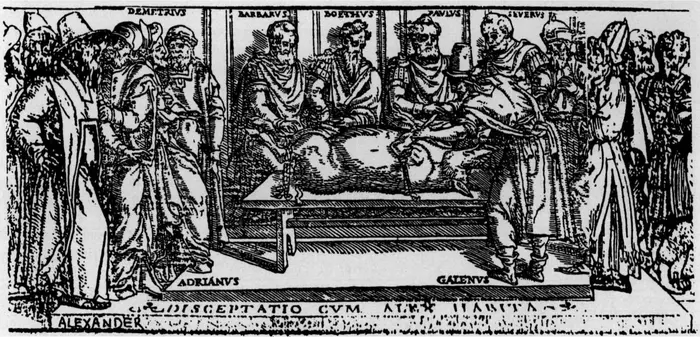1. Animal research in the Age of Antiquity – From Aristotle to Galen
By Aage Kristian Olsen Alstrup, Aarhus University-Hospital PET Center
Humans have conducted animal experiments since the Age of Antiquity.
It is unknown when people tested on animals for the first time. However, we do know that approximately 2.500 years ago, during the Age of Antiquity, the ancient Greeks experimented on farm animals. Later on in the Age of Antiquity, the Romans learned from the Greeks and began to experiment on animals. No records of the number of animals used for these experiments during the Age of Antiquity exists, but it can be assumed that the number was significantly less than the number of experimental animals used today. However, many of the experiments conducted during this time would have been gruesome by current standards, especially considering that the animals were not sedated or anaesthetized. When the Age of Antiquity ended, so did animal testing until it began again during the Renaissance many hundreds years later. This is because other research methods were used during the Middle Ages and these did not require the use of animals for experimentation.
Experiments during the Age of Antiquity

Man was very interested in human anatomy and physiology during Ancient Greek times, and therefore, many human cadaver dissections took place during this time. Many of these dissections had a curious public audience. When human corpses were not available for the dissections, the Greeks resorted to dissecting dead animals instead. Generally, dead animals were used in anatomical studies, while living animals were best for studying physiology.
The oldest known example of such an animal experiment was conducted by Alcmaeon of Croton (born around 510 BC), who was a student of Pythagoras (c. 570-495 BC) the mathematician. Alcmaeon of Croton proved that the optic nerve was necessary for sight after his research animals became blind after he severed their optic nerve (the practice of cutting into something alive is called a vivisection, which is a term that animal welfare groups still use when talking about experimenting on animals).
The Greek physician, Erasistratus of Ceos (304-250 BC), also experimented on living animals and prisoners in Alexandria, Egypt and is considered the father of physiology by many. He proved that the trachea is a windpipe and that the lungs contain air. During this time, another physician in Alexandria by the name of Herophilius (325-255 BC) also conducted vivisections on animals and prisoners sentenced to death.
Both the philosopher Aristotle (384-322BC) and the physician Hippocrates (460-370 BC) conducted experiments on animals, although most of these were on dead animals. Aristotle was able to prove that there were anatomical differences in different animal species. Animal experiments spread from Greece to the Roman Empire. Most famous of all is the Greek physician, Galen of Pergamon (129-200 CE), who lived in Rome and is infamous for having conducted many experiments on animals when he was banned from conducting human experiments. He used pigs, monkeys, birds and lions in his many anatomical, physiological, pathological and pharmaceutical experiments.
The copper engraving shows Galen demonstrating how a bound pig stops screaming when his vocal cord nerves are severed. He conducted these public vivisections to prove that the brain controls behavior. This experiment is one of most famous and infamous physiological experiments ever done on experimental animals. Reportedly, even Galen himself was disgusted by these vivisections.
Scala Naturae
We know very little about how ancient scientists viewed animal suffering, but we can infer it. Aristotle created a system called The Great Chain of being or Scala Naturae, which was based, among other things, on his comparative studies of animal anatomy.
The Scala Naturae classified everything according to rank – everything from a rock to plants, animals and humankind. It was a hierarchical structure that placed animals beneath humans, thus representing that animals exist for the sake of humankind and therefore humans have no moral obligations to them. This was despite the fact that Aristotle claimed that animals have both emotions and memories. Scala Naturae did not only impact the view of experimental animals in the Age of Antiquity, but also in the Middle Ages due to the theologian Thomas of Aquinas (1225-1274) accepting it.
At that time, animal experiments had long since stopped being a scientific method - with few exceptions. The Muslim surgeon Ibn Suhr (1094-1162) developed, refined and tested new surgical procedures on animals (including a tracheotomy on a goat) in Spain before using them on humans. Therefore, we jump directly to the Renaissance period in the next article.